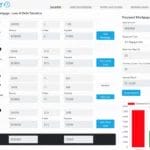
Are you using your Tax Debt as an Overdraft?
May 9, 2023
Benefits of a Debt Consolidation Calculator
October 3, 2023Understanding Mortgage Stress in Australia: Causes and Statistics
Mortgage stress is now a big problem in Australia. Consequently, more and more homeowners are struggling with money because of their owner occupied mortgages and the risk of missing payments or mortgage arrears. So, this article explores the growing issue of higher home loan payments and the stress it causes. At the same time, it looks into the reasons behind why this mortgage stress is happening
Rising Mortgage Stress Statistics:
Recent statistics show mortgage related stress is a concern in Australia. As a result, The RBA and Roy Morgan research define mortgage stress as when a home loan payment uses more than 30% of before-tax household income.
1. Increasing Numbers: Roy Morgan's research shows that for the three months ending in April 2023, a potential risk of mortgage stress is faced by 27.8% of mortgage holders. So, this statistic is of real concern, as it represents the highest percentage in over a decade, close to the previous peak of 28.3% in October 2011.
2. Geographic Disparities: Certain regions exhibit higher rates of home loan related stress. Urban centres and areas with soaring property prices, like Sydney and Melbourne, often report higher instances of homeowners struggling to meet their mortgage payments
3. Demographic Impact: The younger demographic, particularly millennials, faces a greater risk of home loan related stress due to factors like rising property prices and student loan debts.
Underlying Causes for the Increase in Home Loan Related Stress:
Several factors have been noted that add to the growing home loan related stress situation in Australia.
1. Property Price Surge:
Rising property prices, especially in big cities, have gone up faster than people's incomes. Therefore, making it hard for many Australians to pay for their home loans.
2. Interest Rate Increases:
Even though low-interest rates in the past made mortgage payments easier to manage. Certainly, as the reserve bank of australia (RBA) raise interest rates, it will make things even tougher for homeowners. Therefore, increasing the number of homeowners experiencing mortgage stress.
The popularity of part-time or casual employment has risen. As a result, leading to unstable pre-tax income streams that make it hard for homeowners to budget and maintain mortgage payments.
4. Debt Levels:
Australians often carry other forms of debt, such as personal loans and credit card debts, which can add to financial pressures ending in mortgage stress.
5. Lack of Affordable Housing:
A shortage of cheap housing options has forced many individuals into mortgages they can barely afford, leaving them at risk of economic fluctuations.
6. Economic Uncertainty:
Events like the global pandemic have shown the fragility of financial stability. As a result, sudden job losses and economic downturns can exacerbate mortgage stress situations.
7. Household Expenditure:
The current high inflation and the cost of living have further put pressure on household budgets. Certainly, the response from the reserve bank with the lifting of the cash rate has put further pressure on household budgets. As a result, some households are feeling financial stress.
What can be done to reduce Household and Mortgage Stress:
Mortgage Stress is determined when a household is spending more than 30% of its household pre-tax income on housing. As a result, we could split this into 3 basic financial items to discuss in more detail to look at what items can be adjusted and what items are more difficult to change. Consequently, these changes would be intended to improve a households financial situation.
1. Housing
Housing can be split into two major groups which are rental housing and mortgage housing where you own your own home. As we know, this group of expenses can be difficult to change because of contractual arrangements with landlords and banks. However, there could be some ability to reduce mortgage repayments by a refinance or change rental providers.
2. Expenses
Through our many expense assessments, this is an area with a large amount of scope for adjustment. Also, it is an area we find the most resistant to change. However, there are some simple tools or actions that can assist in the process of reducing expenditure.
Initially, track your spending each month. Further, this can be done by downloading your monthly bank statement in an Excel sheet and reviewing your expenses.
Secondly, review your discretionary expenses such as gambling, communications, streaming, and entertainment expenses. Indeed, this is because most clients we find there are 2 to 3 more accounts for the same service than required for the household.
Finally, review your insurance such as car, house, health, life, trauma, and income. Since, as you get older or your income changes so do your premium and cover. As a result, your insurance may need an adjustment to reflect your new circumstance. This way, you can ensure your paying a suitable premium for the correct cover and possibly save some money.
3. Income
Income can possibly be adjusted in a couple of ways. Indeed, changing income can be difficult or relatively easy depending on the situation.
a. Firstly, changing jobs can increase income, but also because you usually need to have a probationary period the new job may also hold more risk of job loss. Therefore, there are two sides to increasing income this way.
b. Secondly, are there extra income streams that may help? Renting a room out? or taking on a border? Of course, this involves a change in lifestyle that may be for better or worse depending on the border.
Government Initiatives and Solutions:
Recognizing the gravity of the situation, Australian authorities have started various measures to help with mortgage stress:
1. Financial Counselling Services:
Government-sponsored financial counsellor services provide guidance to homeowners facing mortgage stress, helping them restructure debts and explore repayment options.
2. Housing Affordability Initiatives:
Governments have introduced schemes to support first-time buyers, increase affordable housing options, and help builders provide low-cost homes.
3. Regulation and Oversight:
Regulatory bodies are keeping a close watch on lending practices to ensure responsible lending and prevent borrowers from being pushed into home loans they can't afford.
Fixed Rates:
Interest rates over the past number of years have been some of the lowest since the 60’s. As a result, over this time a large amount home loans were set on fixed-rate mortgages. However, many of these fixed interest rates are expected to finish in the next 12 months (2023/2024) returning to the current variable rate. For many, this will be the first time they see interest rate rises. Certainly, this is expected to result in a large number of households experiencing a sudden jump in home loan repayments further adding to the number of mortgage holders experiencing mortgage stress in Australia.
Conclusion:
Mortgage stress is still a big deal in Australia. Certainly, numbers show that the problem is getting worse. However, when we look at the reasons, they're complicated. Therefore, focusing on the reasons and planning targeted changes can help alleviate the burden on homeowners and help them avoid mortgage stress. As the country tries to make housing more stable, both the government and businesses need to work together. This will hopefully make a future where families don't have to worry as much about mortgage problems.

